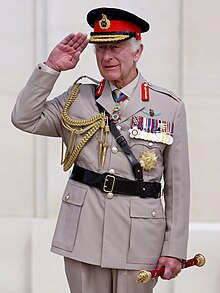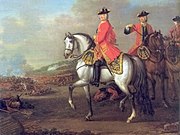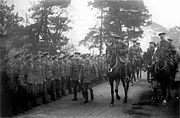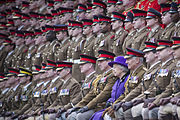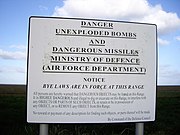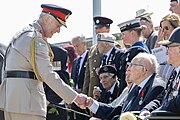Head of the Armed Forces
| Head of The British Armed Forces | |
|---|---|
 | |
 Standard of The Monarch | |
since 8 September 2022 | |
| British Armed Forces | |
| Style | His Majesty |
| Type | Supreme Commanding Authority |
| Status | Commander-in-chief |
| Website | www |
Head of the Armed Forces[1][2][3][4][5][6][7] is the position of the sovereign of the United Kingdom as commander-in-chief of the British Armed Forces.[8] Supreme military authority vests in the monarch and extends to the exercise of several personal prerogatives. However, routine administration of the military is delegated as a matter of law to the Defence Council of the United Kingdom, a body officially charged with the direction and command of the Armed Forces. As the Defence Council and its service boards are all a part of the Ministry of Defence, which itself is a ministerial department of the Government of the United Kingdom, the prime minister makes the key decisions on the use of the Armed Forces, while the secretary of state for defence assists the prime minister in the development of defence policy and administers the day-to-day military operations.
Military oath of allegiance
[edit]Before joining the military all recruits of the British Armed Forces (other than Officers in the Royal Navy and Royal Marines[9]) must take the following oath:
I... swear by Almighty God (do solemnly, and truly declare and affirm) that I will be faithful and bear true allegiance to His Majesty King Charles III, His Heirs and Successors, and that I will, as in duty bound, honestly and faithfully defend His Majesty, His Heirs and Successors, in Person, Crown and Dignity against all enemies, and will observe and obey all orders of His Majesty, His Heirs and Successors, and of the Generals and Officers set over me.[8]
Duties and functions
[edit]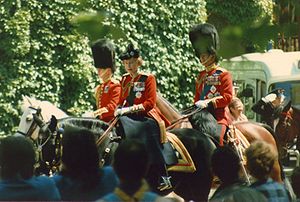
Supreme command and control over the Armed Forces vests in the Sovereign by virtue of the royal prerogative; this constitutional arrangement has existed in the United Kingdom and its successor states since time immemorial.[10][2] As a matter of statute law however, day-to-day administration and control of the military is carried out on behalf of the reigning King or Queen by the Defence Council through the Ministry of Defence and its subordinate service boards. This delegation of command authority extends to matters of mobilisation, the recruitment of non-commissioned officers, and the issuance of commands through the command hierarchy of the three services.[11] That notwithstanding, the delegation of daily command authority does not in any way affect the Crown's personal prerogatives in relation to the Armed Forces.[12][13][14][15][16][17]
A number of powers, duties, and functions are reposed in the Sovereign in his or her capacity as Head of the Armed Forces. Long-standing constitutional convention, however, generally requires the Sovereign to exercise these personal prerogatives in accordance with the advice of ministers of the Crown responsible to Parliament, namely the Prime Minister and His Majesty's Secretary of State for Defence. The Prime Minister (in consultation with the Cabinet) makes the key political decisions on the use of the Armed Forces while the Defence Secretary administers daily military operations.[18] Nevertheless, the supreme military authority belongs to the Sovereign and not to the Government of the day. The Sovereign thus enjoys the right to be consulted before acting on ministerial advice, the right to encourage a given course of military action, and the right to warn against or request a reconsideration of the same.[19][20] In addition, the monarch has a number of reserve powers at his disposal, albeit rarely invoked, to uphold responsible government and prevent unlawful use of the Armed Forces.[21] To this end, the King has plenary authority to:[22][11]
- Declare war, make peace, or institute hostilities falling short of war;
- Issue regulations for the Armed Forces;
- Commission those officers of the Armed Forces who receive their appointment by way of royal warrant, including all flag, senior and junior officers;
- Maintain a Royal Navy;
- Raise an Army, but only when authorised by Parliament pursuant to the Bill of Rights 1689;
- Deploy and use the Armed Forces overseas;
- Deploy and use the Armed Forces on British soil to maintain peace and order in support of civilian government authorities (e.g. to maintain essential services during a strike);
- Order warships in times of urgent national necessity;
- Regulate trade with hostiles;
- Engage in angary in times of war, that is to appropriate the property of a neutral which is within the realm where necessity requires; and
- Exercise extraordinary powers in the event of a grave national emergency, including those to enter upon, take and destroy private property.
As Commander-in-Chief of the Armed Forces, the King closely follows developments in the various armed and security services. He regularly receives the agenda in advance of all Cabinet meetings and its committees, particularly the National Security Council.[23] He also receives the minutes of the meetings of all of these committees and all Cabinet documents.[24] Likewise, the King regularly receives the Secretary of State for Defence in audience to discuss defence documents and policies; if he requires, his Private Secretary can seek additional information from the Ministry of Defence.[25] His Majesty also receives regular reports from the Chief of the General Staff, the First Sea Lord and Chief of the Naval Staff, and the Chief of the Air Staff that cover all important developments in military matters.[26] His Majesty further receives the Chief of the Defence Staff in audience to discuss tri-service military matters.[24]
Relationships with military personnel
[edit]The monarch and the Defence Services Secretary
[edit]The Defence Services Secretary is an officer of the Royal Household. The DSS is appointed by Royal Warrant from the three Services on a rotational basis.[27] The current occupant is Rear Admiral James Norman Macleod. He is the primary channel of communication between the Monarch, in his capacity as Commander-in-Chief of the Armed Forces, and the officers and commands of the British Armed Forces. His office provides the Monarch with the information and documentation related to defence affairs that he requires to perform his military functions. The office was created in 1964 by Queen Elizabeth II as part of the centralization of military affairs into a single defence ministry. The DSS maintains a direct link with the offices of the chiefs of staff of the Army, Navy and Air Force.[28] The Defence Services Secretary is responsible to the King, the Secretary of State for Defence and the Chief of the Defence Staff for tri-service military appointments and works with the Military Secretary, the Air Secretary and Naval Secretary. He submits the names of the officers nominated for promotion to the King through his private secretary. The King makes appointments to the ranks of rear-admiral, major-general, air vice-marshal and above directly.[8]
The monarch and the Ministry of Defence
[edit]The Ministry of Defence is the highest level military headquarters charged with formulating and executing defence policy for the Armed Forces; it employed 57,000 civilians in October 2017.[29]
The command authority of the Armed Forces flows from the monarch, in his capacity as commander-in-chief of the Armed Forces, to the various officers and councils of the defence ministry.[30] The Monarch appoints the members of these committees to exercise day-to-day administration of His Majesty's Armed Forces. The committees are the Defence Council, the Army Board, the Navy Board, the Air Force Board, the Defence Board[31] and the Chiefs of Staffs Committee. The Defence Council, composed of senior representatives of the services and the Ministry of Defence, provides the "formal legal basis for the conduct of defence" and is chaired by the Defence Secretary.[32][33]
The monarch and the command staffs
[edit]Each service branch of the Armed Forces maintains its own command staff that administers the affairs of its service.[34] The staffs receive their authority to act and to exercise command and control over their units from the monarch and his Defence Council.[8]
Until 2012 each of the three services also had one or more commands with a (four-star) commander-in-chief in charge of operations. These were, latterly: Commander-in-Chief Fleet (CINCFLEET – sharing a Command HQ with Commander-in-Chief Naval Home Command (CINCNAVHOME)), Commander-in-Chief, Land Forces (CINCLAND) and Commander-in-Chief Air (CINCAIR). (At one time there were many more Naval, Military and Air Commands, each with (in many cases) their own Commanders-in-Chief.) Since 2012, however, full operational command has been vested in the three Chiefs of Staff, and the appointment of distinct Commanders-in-Chief has been discontinued. This change was implemented in response to the 2011 Levene report, which advised that it would serve to "streamline top-level decision-making, simplify lines of accountability... remove duplication between the posts and also provide impetus to the leaning of the senior leadership".[35]
The monarch and military appointments
[edit]Under the Monarch's regulations for the Army, Navy and Air Force, the Monarch is responsible for making a large number of appointments to senior military posts. Currently the Commander-in-Chief approves appointments at the two-star level and up. The names of the officers appointed to these and other posts in the armed forces are regularly published by the Ministry of Defence.[34][36]
Most military appointments are issued in the form of Letters Patent or a Royal Warrant; both are forms by which the royal will is expressed.[37] The Defence Council of United Kingdom is created by Letters Patent that also set out its powers and membership.[8] The King signs a royal warrant directing the issue of the Letters Patent and ordering the Great Seal of The Realm to be affixed to them. Letters patent are the most formal method of appointment and are used infrequently.[37]
The more frequent and simplest method of appointment is by Royal warrant signed by the Monarch and his Secretary of State for Defence. The Secretary of State first makes an informal submission of the name of a candidate, after the Monarch has signified his approval the Defence Ministry prepares the formal Warrant of Appointment. The Warrants (alongside all other Defence documentation) are sent at the end of each weekday to the King's Private Secretary by Dispatch box.[38] The King and the Secretary of State for Defence then sign the warrant.[27]
-
King George II at the Battle of Dettingen in 1743, by John Wootton. It remains the last time a British monarch personally led his troops into battle.
-
King George V inspecting the British 29th Division prior to the division's departure for Gallipoli in 1915. The division commander, Major General Aylmer Hunter-Weston, rides alongside the King at the right of the photo.
-
Queen Elizabeth II posing for a photograph with soldiers from the Household Cavalry, at Combermere Barracks in 2012.
-
A warning sign posted "By Command of the Defence Council".
-
King Charles III greeting veterans at the British Normandy Memorial in Ver-sur-Mer, France to mark the 80th anniversary of the D-Day landings.
See also
[edit]References
[edit]- ^ Kirsty.Oram (9 January 2017). "The Queen and the Armed Forces". The Royal Family. Retrieved 19 August 2020.
- ^ "Prince Charles promoted to top military rank". Times of Malta. 16 June 2012.
- ^ Howard, Victoria (14 July 2020). "The Queen talks to military personnel in her second video call". The Crown Chronicles.
- ^ "A message from Her Majesty The Queen on Armed Forces Day". The Royal Family. 26 June 2020. Retrieved 30 July 2020.
- ^ "The Queen's heartfelt thanks to military personnel and veterans on Armed Forces Day - read in full". HELLO!. 26 June 2020. Retrieved 29 July 2020.
- ^ "The Royal Family and the Armed Forces". The Royal Household of the United Kingdom. Retrieved 16 August 2024.
- ^ a b c d e "The Queens Regulations for the Army" (PDF). Ministry of Defence. Retrieved 7 July 2020.
- ^ "Commanding officers guide (manual of service law: JSP 830 volume 1), Chapter 18" (PDF). www.gov.uk. 31 January 2011. Retrieved 19 December 2016.
- ^ Emily Haves (13 December 2019). "Prerogative Powers of the Crown". House of Lords Library. Retrieved 16 August 2024.
- ^ a b Review of the Royal Prerogative Powers: Final Report, Ministry of Justice, October 2009, page 32, Retrieved on 12 May 2013.
- ^ "Defence (Transfer of Functions) Act 1964". The National Archives. Retrieved 16 August 2024.
- ^ "The Defence (Transfer of Functions) (Appointed Day) Order 1964". The National Archives. Retrieved 16 August 2024.
- ^ "The Defence (Transfer of Functions) (No.1) Order 1964". The National Archives. Retrieved 16 August 2024.
- ^ "The Defence (Transfer of Functions) (No. 2) Order 1964". The National Archives. Retrieved 16 August 2024.
- ^ "The Defence (Transfer of Functions) Order 1965". The National Archives. Retrieved 16 August 2024.
- ^ "The Transfer of Functions (Civil Defence) Order 2002". The National Archives. Retrieved 16 August 2024.
- ^ Governance of Britain, July 2007. Retrieved on 12 May 2013.
- ^ Bagehot, Walter (1867). The English Constitution. London: Chapman and Hall., p. 103.
- ^ Hansard (4 March 1968). "Rhodesia (Royal Prerogative of Mercy) Debate in the House of Commons". Parliamentary Archives. Retrieved 16 August 2024.
- ^ David Torrance (11 January 2023). "The Crown and the Constitution" (PDF). House of Commons Library. p. 22. Archived (PDF) from the original on 2 March 2023. Retrieved 19 June 2023.
- ^ "Mystery lifted on Queen's powers". The Guardian. 21 October 2003. Retrieved 11 July 2020.
- ^ Publisher HMSO. Aspects of Britain, the monarchy.
- ^ a b Hardman, Robert. A year with the Queen.
- ^ Aspects of Britain, the monarchy. HMSO. p. 27.
- ^ Aspects of Britain, the monarchy. HMSO. pp. 29, 30.
- ^ a b The Royal Encyclopedia. Macmillan Press. p. 23.
- ^ The Royal Encyclopedia. McMillan press. pp. 141, 142.
- ^ Quarterly Civilian Personnel Report (QCPR) (PDF) (Report). Ministry of Defence. 1 October 2017.
- ^ "The Sovereign's soldiers | National Army Museum". www.nam.ac.uk.
- ^ "Our governance". GOV.UK. Retrieved 24 March 2019.
- ^ Defence Organisation, mod.uk
- ^ Defence Council and Chief of the Defence Staff, armedforces.co.uk
- ^ a b "Ministry of Defence". GOV.UK. Retrieved 12 July 2020.
- ^ Defence Reform Steering Group (27 June 2011). Defence Reform: An independent report into the structure and management of the Ministry of Defence (PDF) (Report). Ministry of Defence. ISBN 9780108510663.
- ^ "Ministry of Defence and Tri-Service senior appointments" (PDF). Retrieved 30 July 2020.
- ^ a b The Royal Encyclopedia. Macmillan Press. pp. 312, 487, 23.
- ^ The Royal Encyclopedia. Macmillan Press. p. 56.

